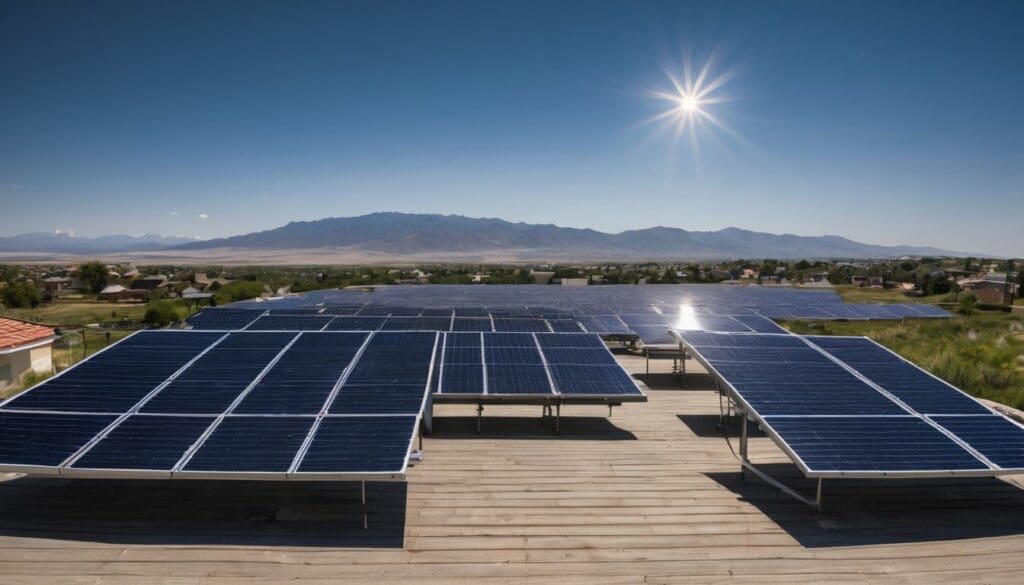Are your electricity bills causing you a bit of bother every month? It’s a common gripe, and with energy costs creeping ever upwards, seeking out an efficient alternative is becoming quite the priority.
You might find it staggering to know that in just one hour, the sun beams down more than enough energy to supply our homes and businesses for an entire year! Our guide thoughtfully unpacks how you can tap into this astounding natural resource for your abode, potentially trimming those pesky bills and doing a good turn for the environment at the same time.
Are you ready to bask in the glow of solar savings?.
Key Takeaways
- Solar panels use photovoltaic cells to convert sunlight into electricity, cutting down on household energy bills and reducing dependency on non-renewable sources.
- Government incentives can lower the cost of solar panel installation, making it a financially viable option for many homeowners.
- Proper placement of solar panels ensures maximum efficiency; south-facing roofs in the Northern Hemisphere are usually ideal.
- Regular maintenance and cleaning of solar panels enhance their performance and longevity.
- Financial solutions such as loans, leasing or power purchase agreements are available to help manage the upfront costs of going solar.
The Benefits of Going Solar
By harnessing the power of solar energy, homeowners can significantly reduce their electricity bills and contribute to a cleaner, more sustainable environment. Solar power is a renewable energy source that offers both financial savings and environmental benefits.
https://www.youtube.com/watch?v=LQe7aaYehzc
Reduced electricity bills
Switching to solar power at home is a game-changer for our monthly spending. Immediately, we notice a drop in electricity bills because the energy from the sun costs nothing once we’ve installed photovoltaic systems.
Generating electricity with solar panels during peak sunlight hours means less reliance on expensive utilities and more cost savings.
Easing our dependency on non-renewable power sources also qualifies us for government incentives that reward making sustainable choices. These incentives can slash installation costs significantly, boosting our savings even further.
With each passing month, as we watch our energy bills decrease, it’s clear how much of an impact residential solar panels have on managing household finances effectively.
Environmental benefits
Solar power offers significant environmental benefits to homeowners. By generating electricity from the sun, solar panels reduce the reliance on fossil fuels, thus lowering carbon emissions and contributing to a healthier planet.
This renewable energy source also conserves natural resources and minimises pollution, making it a sustainable choice for environmentally conscious individuals seeking to reduce their carbon footprint.
Switching to solar power not only reduces your home’s impact on the environment but can also lead to long-term savings, providing an eco-friendly alternative while promoting a greener future.
Renewable energy source
Renewable energy source, solar power offers a sustainable and environmentally friendly alternative to traditional electricity sources. By harnessing the power of the sun, homeowners can reduce their carbon footprint and contribute to a cleaner planet.
Solar energy for residential use is not only cost-effective but also promotes energy efficiency and sustainable living practices, aligning with the values of environmentally conscious individuals.
Investing in solar power at home presents an opportunity to embrace clean energy solutions while significantly reducing reliance on non-renewable resources. With government incentives for solar panels and various financing options available, transitioning to renewable energy for your home is now more accessible than ever before.
Embracing solar power not only benefits homeowners through reduced energy bills but also empowers them to take an active role in promoting a greener future for all.
Understanding how solar power works lays the foundation for making informed decisions about embracing this eco-friendly technology, empowering you as you move towards reducing your environmental impact through sustainable living practices.
Transitioning to renewable energy sources like solar power ensures that we are contributing positively to our environment while reaping numerous benefits as homeowners looking towards a brighter future powered by green technology.
How Solar Power Works
Solar power works through photovoltaic cells that convert sunlight into electricity, which is then transformed by an inverter for use in your home. The excess energy can be fed back into the grid, providing a sustainable and renewable source of power.
Photovoltaic cells
Photovoltaic cells, also known as solar cells, convert sunlight into electricity. When light hits the cell, it creates an electric field across the layers causing electricity to flow.
This process occurs without any moving parts and releases zero emissions, making it a clean energy source for your home. Photovoltaic cells are made from semiconductor materials like silicon and can be found in solar panels installed on rooftops or in large-scale solar farms.
Understanding how photovoltaic cells work is crucial to harnessing the power of solar energy for your home. By selecting efficient solar panels with quality photovoltaic cells, you can maximise energy production and reduce your dependence on traditional grid-tied power sources.
To fully comprehend the benefits of photovoltaic cells, let’s delve into the role of inverters in converting direct current (DC) electricity produced by these cells into alternating current (AC) electricity suitable for powering your home appliances.
Inverter
The inverter is a crucial component of a solar power system. It takes the direct current (DC) electricity generated by the photovoltaic cells and converts it into alternating current (AC) electricity, which is what powers your home.
This process is essential because most home appliances and electronic devices run on AC power, so the inverter ensures that the electricity produced by your solar panels can be used throughout your household.
An efficient inverter maximises the amount of usable energy from your solar panels, ultimately saving you more money on your electricity bills. When choosing an inverter for your solar system, it’s important to consider factors such as its efficiency, durability, and compatibility with other components of your setup.
Connection to the grid
When connecting your solar power system to the grid, it is crucial to engage a certified electrician. The connection enables you to feed excess energy back into the grid and receive credits for the electricity produced by your panels.
This makes your home an active participant in sustainable energy production and helps offset costs during periods of low sunlight. It’s important that this process complies with local regulations and standards, ensuring safety and reliability.
Understanding how solar power connects to the grid provides homeowners with confidence in their renewable energy investment. Let’s now explore the steps involved in assessing our energy usage before finding a reputable solar installer.
Steps to Going Solar
Assess your energy usage, find a reputable solar installer, and explore financing options for your home – all essential steps in transitioning to solar power. Read on to discover how these practical tips can help you make the switch to renewable energy.
Assessing your energy usage
To determine the right solar power system for your home, calculate your average energy consumption. This can help you understand how many solar panels and what size inverter you may need.
Reviewing past utility bills is a good start to identify seasonal trends and peak usage times, which informs where to focus on saving energy. Additionally, consider conducting an energy audit or using an online calculator that provides estimates based on household size and usage patterns.
Understanding our energy consumption helps us make informed decisions about installing solar power systems that suit our needs and contribute to long-term cost savings. Taking these steps allows us to reduce our reliance on traditional energy sources and embrace sustainable alternatives like solar power, promoting environmental conservation.
Finding a reputable solar installer
When looking for a reputable solar installer, it’s essential to conduct thorough research and seek recommendations from trusted sources. Start by gathering quotes from multiple installers to compare pricing and services.
Ensure that the chosen installer is accredited by relevant industry bodies and has a proven track record of successful installations. Reading customer reviews can also provide valuable insights into the quality of work and customer satisfaction.
Additionally, don’t hesitate to ask for references and inquire about warranties provided for the solar panels and installation.
To make an informed decision when choosing a solar installer, verify their qualifications, experience, and certifications in renewable energy installation. Engage in open communication with potential installers to discuss your specific needs, budget constraints, and any concerns you may have.
Financing options
Considering the cost of installing solar panels, financing options are available to make this investment more affordable. Loans specifically designed for solar installations can help cover initial expenses, and some government incentives and rebates may also be accessible.
Exploring leasing or power purchase agreements with a reputable solar company could provide an alternative option to reduce the upfront costs. It’s important to research and consult with professionals in the field to find the best financial solution that suits your individual circumstances.
– Practical Tips for Installing Solar Panels
Practical Tips for Installing Solar Panels
– Choosing the right location for your solar panels is crucial to maximise sunlight exposure. Regular maintenance and cleaning of the panels will ensure optimal efficiency. Understanding the installation process will help you monitor and troubleshoot any issues that may arise.
Choosing the right location
To maximise the efficiency of your solar panels, it’s vital to select an ideal location for installation. Seek out areas with minimal shading throughout the day to ensure optimal sunlight exposure.
Additionally, consider the angle and orientation of your roof or land space to capture as much sunlight as possible, enhancing the performance of your solar power system.
When evaluating different locations, keep in mind that south-facing roofs generally receive more sunlight in the Northern Hemisphere. By paying attention to these factors when choosing a location for your solar panels, you can significantly increase their energy output and make a positive impact on both your energy bills and the environment.
Proper maintenance and cleaning
After choosing the right location for your solar panels, it is crucial to prioritise proper maintenance and cleaning. Regularly inspecting and cleaning your solar panels ensures maximum efficiency in converting sunlight into electricity.
Removing dirt, dust, leaves, and other debris from the surface of the panels will help optimise their performance. Additionally, scheduling professional maintenance checks at least once a year can identify any potential issues early on and keep your system running smoothly.
When it comes to cleaning, using a soft brush or cloth with mild detergent and water is usually sufficient to remove grime without damaging the panels. However, it’s essential to follow manufacturer guidelines and seek professional assistance for more extensive cleaning if needed.
Understanding the installation process
When installing solar panels, it is important to choose the right location to ensure maximum sunlight exposure. Proper maintenance and cleaning are crucial for optimising energy production from your solar panels.
Working with a reputable solar installer can help you navigate the installation process smoothly.
After assessing your energy usage and choosing a suitable financing option, finding a reputable solar installer who understands local regulations and building codes will ensure a seamless installation process.
Conclusion
By understanding how solar power works and following these practical tips, homeowners can easily and effectively transition to a solar-powered home. Making the switch to solar energy can benefit both your wallet and the environment.
Making the switch to solar energy can benefit both your wallet and the environment. By understanding how solar power works and following these practical tips, you can easily and effectively transition to a solar-powered home.
Switching to solar energy benefits both your wallet and the environment. By understanding how solar power works, finding a reputable solar installer, and choosing the right location for installation, you can transition to a solar-powered home effectively.
Assessing your energy usage, financing options, and proper maintenance are key steps in installing solar panels at home.
Understanding how solar power works is essential when transitioning to a solar-powered home. Following practical tips such as assessing your energy usage, finding a reputable solar installer, and choosing the right location for installation will help you make an effective switch to renewable energy.
FAQs
1. What are the benefits of installing solar power at home?
Installing solar power can help you reduce energy bills, contribute to home sustainability, and make use of renewable energy for your household needs.
2. Is it possible to install a DIY solar power system?
Yes, homeowners can set up DIY solar electricity systems with the right tools and a comprehensive Solar panel installation guide.
3. How does offgrid solar power differ from gridtied systems?
Offgrid solar power allows you to live independently without relying on public utilities, while gridtied systems let you stay connected to the utility grid for backup or excess energy storage.
4. What’s the cost of adding solar panels for residential use?
The cost of solar power for residential use varies but investing in home solar power often leads to significant savings on your electricity expenses over time.
5. Can I rely completely on renewable energy by using a home solar power system?
Yes, with proper installation and planning, your home can operate solely on renewable energy provided by a well-designed off-grid living setup.





